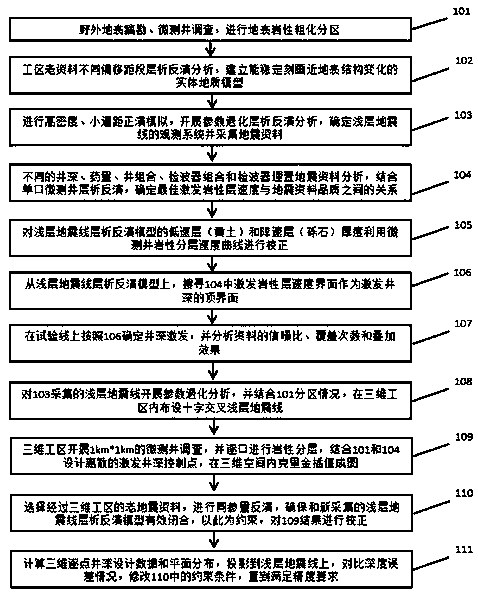Point-line-plane three-dimensional point-by-point well depth design method
A well depth design and three-dimensional technology, applied in geophysical surveying, instruments, etc., can solve the problems of complex and variable thickness and speed of the speed-down zone, inaccurate well depth, and low precision of surface structure investigation, achieving strong systematization and implementability effectiveness, ensuring rationality and accuracy, and improving accuracy
- Summary
- Abstract
- Description
- Claims
- Application Information
AI Technical Summary
Problems solved by technology
Method used
Image
Examples
Embodiment Construction
[0036] In order to make the above and other objects, features and advantages of the present invention more comprehensible, the preferred embodiments are listed below and shown in the accompanying drawings in detail as follows.
[0037] like figure 1 as shown, figure 1 It is a flow chart of the point-line-plane three-dimensional point-by-point well depth design method of the present invention.
[0038] Step 101, field surface survey and lithology division;
[0039] Step 102, establishing a near-surface forward modeling model for tomographic inversion of old data in the work area;
[0040] Step 103, design the acquisition parameters of the shallow seismic line by forward modeling; carry out high-density, small track spacing forward modeling, carry out parameter degradation tomographic inversion analysis, determine the observation system of the shallow seismic line and collect seismic data;
[0041] Step 104, selecting test points and researching excitation receiving factors t...
PUM
 Login to View More
Login to View More Abstract
Description
Claims
Application Information
 Login to View More
Login to View More - R&D
- Intellectual Property
- Life Sciences
- Materials
- Tech Scout
- Unparalleled Data Quality
- Higher Quality Content
- 60% Fewer Hallucinations
Browse by: Latest US Patents, China's latest patents, Technical Efficacy Thesaurus, Application Domain, Technology Topic, Popular Technical Reports.
© 2025 PatSnap. All rights reserved.Legal|Privacy policy|Modern Slavery Act Transparency Statement|Sitemap|About US| Contact US: help@patsnap.com



